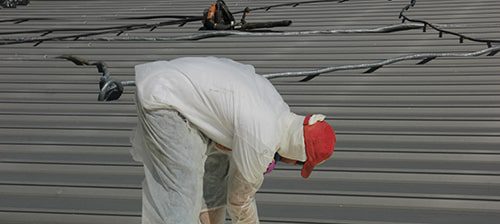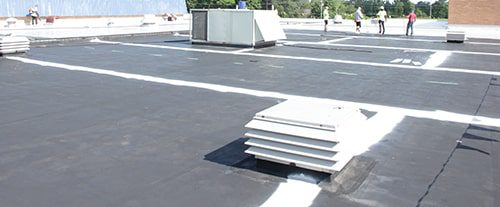Somebody called the other day to talk with me about their roof. They said they had some fractures in the roof and that a roofing contractor proposed a solution.
They said the contractor wanted to install a silicone roof coating system over their existing roof, which had some fractures.
The caller asked me if this was ok to do, and I replied, well, that depends on two factors:
1. What existing roof do you have?
Because you can’t apply silicone coatings to every type of roof.
2. Are there plans for preparing your roof before the coating is installed?
Because if not, the coating won’t last very long, blisters can occur, adhesion issues can happen, and you’ll be one unhappy customer.
We’ll dive into each of these questions in more detail below. But first, why are so many building owners interested in silicone roof coatings all of a sudden?
Why are building owners installing silicone coatings over their existing roofs?
There are many benefits to installing a silicone roof coating system.
Benefit #1 – It’s more cost-effective than a complete roof replacement
Some building owners think that the only option they have is to completely remove the entire roof down to the deck and then install a new roofing system.
If your roof is in decent shape, meaning that 75% or more of your roof’s insulation is dry, then it’s usually more cost-effective to restore the roof with coating than to completely replace it.
A silicone roof coating restoration costs around $3.50 – $7 per square foot. A complete roof replacement can cost around $4 – $10 per square foot.
NOTE: the prices are estimates. Many factors fluctuate the cost of the roof installation.
Benefit #2 – silicone coating is not considered another roofing system
Per building code, a commercial roof can have a maximum of two roofing systems. If you’re going to install another roofing system, you’ll need to remove at least one roof system before installing a new one.
Removing an entire roof system is labor-intensive and there are costs with transporting materials to landfills.
However, adding silicone coating to a roof is not considered another roof system, it’s considered maintenance.
Therefore, you only need to remove the saturated areas of a roof before installing the coating.
On a roof that’s restored with silicone, you may only have to remove, replace, and transport 25% of that roof, but if you already have two roof systems, and you want to install a new one, you’ll have to remove, replace, and transport 100% of that roofing system.
There are many other benefits to silicone roof coating systems, but I wanted to dive into the meat of the article, talking about coating over existing roof systems and ones that have fractures, cracks, or holes.
What existing roof systems can silicone coating be installed over?

When I was talking to the caller, I forgot to ask what kind of roof their building has.
If they had a single-ply roof, metal, or a smooth built-up roof, then a silicone roof system can be cost-effectively installed.
If they said gravel built-up, I’d recommend a different solution.
Why?
If you broom off the gravel and install coating, the coating will peel right off in a few months. If you broom off the gravel and power wash the surface so all the dirt is removed, it will require an extraordinary amount of coating to fill in (and surpass) all the embedment’s the gravel made over all those years.
Coming from a commercial roofing expert with 30+ years of experience, it would cost about 4 times as much to properly install a silicone coating system over a gravel built-up roof than it would be to install another roofing system, such as spray polyurethane foam.
Let’s give the caller the benefit of the doubt and say that they didn’t have a gravel built-up roof. But, the existing roof still has fractures, holes, and cracks. What needs to be done before the coating can be installed?
How’s an existing roof prepared before the silicone coating can be installed?
If you have a roof with fractures, holes, and cracks, you cannot simply add coating over the entire field of the roof and expect the roof to remain watertight for very long.
This is because there’s water trapped in your insulation that came through the fractures, holes, and cracks every time it’s rained.
So, what does a roofing contractor do?
Here are the steps to prepare a commercial roof before installing silicone coating:
- Step 1 – Perform an infrared survey and/or pull core samples to identify the saturated areas
- Step 2 – Remove and replace those saturated areas with dry, similar materials
- Step 3 – Clean the roof with a power washer
- Step 4 – Perform an adhesion test and use a primer if needed
- Step 5 – Reinforce all seams with polyester-reinforced mesh or self-adhering, reinforcing tape
- Step 6 – Spray or roll silicone (depending on the wind and overspray potential) per manufacturer’s specifications in order to grant the manufacturer’s warranty.

What happens if a roof isn’t prepared correctly?
If a contractor doesn’t remove all the saturated areas before installing a coating system, the water can freeze in the Winter and crack the insulation. In the Summer, water trapped in insulation will not evaporate and therefore can cause the rotting of your metal or wood deck.
If a contractor doesn’t clean the roof properly, the coating will not adhere correctly and can peel off the existing roof in a matter of months; which will be a disappointment when you expected the coating to last for 10+ years.
If a contractor doesn’t perform an adhesion test, the coating might not adhere correctly. Perhaps a different type of silicone coating could be used that will adhere better to your existing roof?
If a contractor doesn’t reinforce the seams, the seams can break apart and cause an opening in the roof system. Seams losing adhesion are one of the most popular ways water can enter a roofing system. Giving extra treatment in these areas is a piece of mind that the roof will last as long as possible.
If a contractor doesn’t install the proper millage (or thickness of silicone), then a warranty will not be granted by the manufacturer until the proper millage is installed.
For a 10-year warranty, 20 mils of coating are installed over the field of the roof.
For a 15-year warranty, 25 mils of coating are installed over the field of the roof.
For a 20-year warranty, 30 mils of coating are installed over the field of the roof.
NOTE: the amount of coating can vary per manufacturer’s warranty requirements
What are you supposed to do now with your fractured or cracked roof?
Now that you know that installing silicone coating is a cost-effective way to restore your roof that has some fractures, holes, or cracks, your next step is to see how much of your insulation is saturated.
If less than 25% of your insulation is saturated, then more than likely it’ll be cost-effective to restore your roof with coating.
If more than 25% of your insulation is saturated, it’s probably more cost-effective to remove the entire roof and install a new system.
Either way, you’ll need to get core samples pulled and possibly get an infrared inspection to see the health of your roof.
Here’s a link to learn more about infrared inspections.


